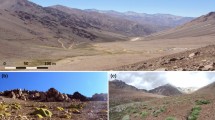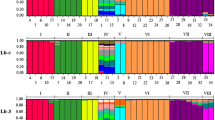Abstract
We report the successful amplification of microsatellite markers for the chloroplast genome from century-old samples of 2 grasses growing in the Park Grass Experiment (PGE):Anthoxanthum ordoratum andFestuca rubra. This opens the possibility of establishing a long-term genetic time series for the PGE, which began in 1856 and is believed to be the oldest ecological experiment in existence. Although the plant samples used were not originally prepared or stored with molecular analysis in mind, the hexadecyltrimethylammonium bromide (CTAB) method of DNA extraction was successfully used. Obtained DNA was degraded but could be amplified by means of PCR. It produced bands around the expected size for chloroplast microsatellite primers derived from rice. When sequenced, bands showed good homology with sequences from rice chloroplast genomes listed in GenBank (accession No X15901).
Similar content being viewed by others
Abbreviations
- AFLP:
-
amplified fragment length polymorphism
- CTAB:
-
hexadecyl-trimethylammonium bromide
- ISSR:
-
inter-simple sequence repeat
- PGE:
-
Park Grass Experiment
References
Cano RJ, Poinar HK, Pieniazek NJ, Acra A, and Poinar Jr GO (1993) Amplification and sequencing of DNA from a 120–135 million-year-old weevil. Nature 363: 536–538.
Cashen RO (1947) The influence of rainfall on the yield and botanical composition of permanent grass at Rothamsted. J of Ag Sci 37: 1–10.
Cheng K-T, Chang H-C, Su C-H, and Hsu F-L (1997) Identification of dried rhizomes ofCoptis species using random amplified polymorphic DNA. Bot Bull Acad Sin 38: 241–244.
Csaikl UM, Bastian H, Brettschneider R, Gauch S, Meir A, Schauerte M, Scholz F, Sperisen C, Vornam B, and Ziegenhagen B (1998) Comparative analysis of different DNA extraction protocols: a fast, universal maxi-preparation of high quality plant DNA for genetic evaluation and phylogenetic studies. Plant Mol Biol Rep 16: 69–86.
Davies MS and Snaydon RW (1976) Rapid population differentiation in a mosaic environment. III. Measures of selection pressures. Heredity 36: 59–66.
Dodd M, Silvertown J, McConway K, Potts J, and Crawley M (1995) Community stability a 60-year record of trends and outbreaks in the occurrence of species in the Park Grass Experiment. J of Ecol 83: 277–285.
Fu R-Z, Wang J, Sun Y-R, and Shaw P-C (1998) Extraction of genomic DNA suitable for PCR analysis from dried plant rhizomes/roots. BioTechniques 25: 797–801.
Grunewald K, Lyons J, Hansen-Hagge TE, Janssen JWG, Feichtinger H, and Bartram CR (1991) Molecular genetic analysis of DNA obtained from fixed, air dried or paraffin embedded sources. Ann Hematol 62: 108–114.
Ishii T and McCouch SR (2000) Microsatellites and microsynteny in the chloroplast genomes ofOryza and eight otherGramineae species. Theor Appl Genet 100: 1257–1266.
John ME (1992) An efficient method for isolation of RNA and DNA from plants containing polyphenolics. Nucl Acids Res 20: 2381.
Matsuo S, Toyokuni S, Osaka M, Hamazaki S, and Sugiyama T (1995) Degradation of DNA in dried tissues by atmospheric oxygen. Biochem and Biophys Res Comm 208: 1021–1027.
Paabo S (1993) Ancient DNA. Sci. Am Nov: 60–66.
Parmesan C and Yohe G (2003) A globally coherent fingerprint of climate change impacts across natural systems. Nature 421: 37–42.
Powell W, Morgante M, McDevitt R, Vendramin GG, and Rafalski JA (1995) Polymorphic simple sequence repeat regions in chloroplast genomes: applications to the population genetics of pines. Proc Natl Acad Sci USA 92: 7759–7763.
Provan J, Powell W, and Hollingsworth PM (2001) Chloroplast microsatellites: new tools for studies in plant ecology and evolution. Trends in Ecol and Evol 16: 142–147.
Rogers SO and Bendich AJ (1985) Extraction of DNA from milligram amounts of fresh, herbarium and mummified plant tissues. Plant Mol Biol 5: 69–76.
Silvertown J, Dodd ME, McConway K, Potts J, and Crawley M (1994) Rainfall, biomass variation, and community composition in the Park Grass. Experiment. Ecol 75: 2430–2437.
Silvertown J, McConway KJ, Hughes Z, Biss P, Macnair M, and Lutman P (2002) Ecological and Genetic Correlates of Long-Term Population Trends in the Park Grass Experiment. Am Nat 160 (4): 409–420.
Singh M, Ahuja B, and Ahuja PS (1999) Isolation and PCR amplification of genomic DNA from market samples of dry tea. Plant Mol Biol Rep 17: 171–178.
Stacey J and Isaac P (1994) Isolation of DNA from plants. In: Isaac PG (ed), Methods in Molecular Biology, vol. 28. Protocols for Nucleic Acid Analysis by Non-Radioactive Probes, pp 9–15, Humana Press, Totowa, NJ.
Thomas CD, Bodsworth EJ, Wilson RJ, Simmons AD, Davies ZG, Musche M, and Conradt L (2001) Ecological and evolutionary processes at expanding range margins. Nature 411: 577–581.
Vos P, Hogers R, Bleeker M, Reijans M, van de Lee T, Hornes M, Frijters A, Pot J, Peleman J, Kuiper M, and Zabeau M (1995) AFLP: a new technique for DNA finger-printing. Nucl Acids Res 23 (21): 4407–4414.
Wayne RK, Leonard JA, and Cooper A (1999) Full of Sound and Fury: History of Ancient DNA. Ann Rev Ecol Syst 30: 457–477.
Zietkiewicz E, Rafalski A, and Labuda D (1994) Genome fingerprinting by simple sequence repeat (SSR)-anchored polymerase chain reaction amplification. Genomics 20: 176–183.
Author information
Authors and Affiliations
Corresponding author
Rights and permissions
About this article
Cite this article
Biss, P., Freeland, J., Silvertown, J. et al. Successful amplification of rice chloroplast microsatellites from century-old grass samples from the park grass experiment. Plant Mol Biol Rep 21, 249–257 (2003). https://doi.org/10.1007/BF02772800
Published:
Issue Date:
DOI: https://doi.org/10.1007/BF02772800




